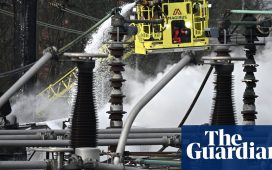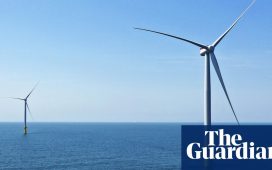As the fertile arable land of historic Kincardineshire meets the foothills of the Grampian mountains, a solitary wind turbine stands 70 metres high.
Local residents are up in arms about plans to build “monster pylons” near the designated special landscape area, the Braes of the Mearns, part of a £20bn upgrade to northern Scotland’s national grid critical to connecting 50GW of offshore wind power by 2030.
Rising resistance to large pylons across the landscape is a central issue in some northern Scottish seats in next month’s general election and threatens to delay hitting national net zero targets — which envision a three-fold increase in offshore wind power while also providing Scotland with a sizeable industrial opportunity.
“The talk is of a just transition — that no one will be left behind — but we have all been left behind,” said Kate Matthews, an antiques dealer campaigning against the pylon proposals. “We’re a bit like a swarm of midges, annoying SSEN until this stops.”

For the past year, Matthews and fellow activist Tracey Smith have been mounting a campaign against SSEN Transmission’s proposed high-voltage overhead lines snaking through 65 miles of rolling hills and potato fields near Scotland’s north-east coast.
They have raised funds for legal action against the infrastructure upgrades once planning permissions are lodged at the council. “Delay is our friend,” said Matthews.
An earlier grid expansion project, the Beauly-Denny line, was subject to the country’s longest-ever public inquiry, receiving 20,000 objections and taking more than a decade to be completed in 2015.
Labour, which hopes to take dozens of seats in urban Scotland, has pledged to win the global renewables race through a state-owned company based in Scotland, GB Energy.

The party manifesto says the national grid is “the single biggest obstacle” to clean power, pledging to “upgrade our national transmission infrastructure and rewire Britain”. Anas Sarwar, Scottish Labour leader, on Tuesday said his party would go “hell for leather” to upgrade the grid by breaking down planning barriers.
As it implements the northern Scottish leg of the national network expansion, SSEN has been holding dozens of consultation events with local communities, seeking feedback on proposed designs and changing some routes based on the responses.
The company said it is building the infrastructure needed to reach UK and Scottish net zero targets “in a way that balances technical, environmental and cost considerations, taking into account the impact on communities”. No final decisions have been made, it added. Figures released on Tuesday showed that Scotland had failed to meet its 2022 target for reducing greenhouse gas emissions.

Many of those in the shadow of the proposed route question the plan’s impact on tourism and agriculture, calling for other options, such as underground and offshore cabling used in some European grids, to protect the natural habitat and domestic food security.
Shrugging off cash compensation and a £100mn community benefit fund, they fear an instant impact on house prices and longer term concern about the “industrialisation” of the countryside, given plans for more offshore wind power and onshore battery storage projects in Scotland.
SSEN has confirmed that the operator of the national grid is scheduled to outline further expansion plans next year. Energy regulator Ofgem has said 800GW of electricity projects are in the queue for connections to the UK grid by the end of this year — four times the amount of electricity generation needed by 2050.
The pylons furore — along with the future of Aberdeen’s oil and gas industry — has electrified the election campaign in West Aberdeenshire and Kincardine, which extends from the Cairngorm Mountains to the port of Stonehaven.

The constituency moved from its longtime custodians, the Liberal Democrats, to the SNP in its 2015 post-independence referendum surge. Andrew Bowie snatched it for the Conservatives in 2017 and defended the seat in 2019 with a majority of just 843. Another close race is expected.
On the hot-button issue of pylons, the Conservatives have vowed to launch a review to consider laying cables underground “where cost-competitive”.
“This infrastructure is going to be built all around the country, so let’s get it right,” said Bowie. “If it takes a little longer, so be it, otherwise we won’t take communities with us.”

Promoting the review in the run-up to the election has sparked accusations of electioneering from other candidates. Glen Reynolds of the SNP said he had been calling out the “elephant in the room” of public resistance to the plan before the Conservatives decided to launch the review, which he welcomes.
“This should have been done years ago,” he said, calling for a pause in the process that could lead to a combination of options, such as more subsea and underground cabling, without necessarily causing a “lengthy” delay.
Michael Turvey, the Liberal Democrat candidate for West Aberdeenshire and Kincardine, has proposed a radical reworking of the grid expansion plan. This involves leveraging the area’s oil and gas expertise to build offshore substations and lay more expensive subsea cabling to transport electricity to the centres of demand.
He blames both the Conservatives in Westminster, who oversee energy infrastructure, and the SNP in Holyrood, where the Scottish government is in charge of providing consent for electricity generation stations and power lines, for mismanaging the entire process.
“The Conservatives are the bowler here and the SNP are the wicket keeper,” he said.











